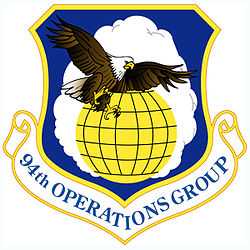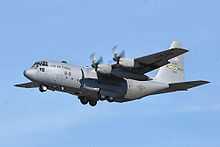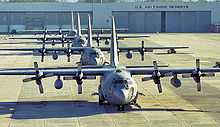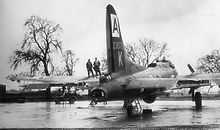94th Operations Group
| 94th Operations Group | |
|---|---|
 Emblem of the 94th Operations Group | |
| Active | 1943–1945; 1947–1951; 1952–1959; 1992–present |
| Country | United States |
| Branch | United States Air Force |


The 94th Operations Group (94 OG) is the flying component of the 94th Airlift Wing, assigned to the United States Air Force Reserve. The group is stationed at Dobbins Air Reserve Base, Georgia.
During World War II, its predecessor unit, the 94th Bombardment Group (Heavy) was an Eighth Air Force B-17 Flying Fortress unit in England, stationed at RAF Bury St. Edmunds. The group flew 324 combat missions and was awarded two Distinguished Unit Citations, 17 August 1943: Operations over Regensburg, and 11 January 1944 over Brunswick. Its last mission was flown on 21 April 1945.
Overview
The 94th Operations group is the flying component of the 94th Airlift Wing. Its primary mission is to train C-130H aircrews for the United States Air Force – active duty, guard and reserve components. Its second mission is to maintain combat ready units to deploy on short notice to support contingencies anywhere in the world.
Assigned Units
- 700th Airlift Squadron
- 94th Aeromedical Evacuation Squadron
- 94th Operations Support Squadron
- 94th Airlift Control Flight
History
- For additional history and lineage, see 94th Airlift Wing
Lineage
- Established as 94th Bombardment Group (Heavy) on 28 January 1942
- Activated on 15 June 1942
- Redesignated 94th Bombardment Group, Heavy on 20 August 1943
- Inactivated on 21 December 1945
- Redesignated 94th Bombardment Group, Very Heavy on 13 May 1947
- Activated in the Reserve on 29 May 1947
- Redesignated 94th Bombardment Group, Light on 26 June 1949
- Ordered to Active Service on 10 March 1951
- Inactivated on 20 March 1951
- Redesignated 94th Tactical Reconnaissance Group on 26 May 1952
- Activated in the Reserve on 14 June 1952
- Redesignated: 94th Bombardment Group, Tactical on 18 May 1955
- Redesignated: 94th Troop Carrier Group, Medium on 1 July 1957
- Inactivated on 14 April 1959
- Redesignated: 94th Tactical Airlift Group on 31 July 1985 (Remained inactive)
- Redesignated: 94th Operations Group on 1 August 1992
- Activated in the Reserve on 1 August 1992.
Assignments
|
|
Components
- 331st Bombardment (later, 731st Troop Carrier) Squadron (PN): 15 June 1942 – 29 November 1945; 29 May 1947-20 March 1951; 14 June 1952 – 14 April 1959
- 332d Bombardment (later, 732d Troop Carrier) Squadron (XM): 15 June 1942 – 15 December 1945; 29 May 1947-20 March 1951; 14 June 1952 – 14 April 1959
- 333d Bombardment (Later, 733d Troop Carrier) Squadron (TS): 15 June 1942 – 1 December 1945; 29 May 1947-20 March 1951; 14 June 1952 – 18 May 1955
- 410th Bombardment Squadron (GL): 15 June 1942 – 19 December 1945; 17 July 1947-20 March 1951
- 700th Airlift Squadron: 1 August 1992–present
Stations
|
|
Aircraft assigned
|
|
Operational history
World War II



Activated 15 June 1942 at McDill Field FL. Nucleus established Pendleton Field, Ore, on 29 June 1942 and engaged in initial training. Detailed training at Davis-Monthan Fielf in Arizonia between 28 August 1942 and 31 October 1942 and at Biggs Field Texas between 1 November 1942 and 2 January 1943. Final phase training at Pueblo Colorado on January 1943 to the end of March 1943. Air echelon began movement overseas on 1 April 1943. The ground element left for Camp Kilmer, New Jersey on 17 April 1943 and sailed on the Queen Elizabeth on 5 May 1943, and arriving in Greenock on 11 May 1943. The 94th was assigned to the Eighth Air Force 4th Combat Bombardment Wing, and the group tail code was a "Square-A".
The 94th flew its first mission on 13 June 1943, bombing an airfield at Saint-Omer. After that, the group attacked such strategic objectives as the port of St Nazaire, shipyards at Kiel, an aircraft component parts factory at Kassel, a synthetic rubber plant at Hanover, a chemical factory at Ludwigshafen, marshalling yards at Frankfurt, oil facilities at Merseburg, and ball-bearing works at Eberhausen.
The group withstood repeated assaults by enemy interceptors to bomb an aircraft factory at Regensburg on 17 August 1943, being awarded a Distinguished Unit Citation for the mission. Braving adverse weather, heavy flak, and savage fighter attacks, the group completed a strike against an aircraft parts factory in Brunswick on 11 January 1944 and received a 2d DUC for this operation.
The 94th took part in the campaign of heavy bombers against the enemy aircraft industry during Big Week, 20–25 February 1944. Sometimes operated in support of ground forces and flew interdictory missions. Prior to D-Day in June 1944, helped to neutralize V-weapon sites, airfields, and other military installations along the coast of France. On 6 June the group bombed enemy positions in the battle area to support the invasion of Normandy. Struck troops and gun batteries to aid the advance of the Allies at Saint-Lô in July and at Brest in August. Covered the airborne attack on Holland in September. Hit marshalling yards, airfields, and strong points near the combat area during the Battle of the Bulge, December 1944 – January 1945. Bombed transportation, communications, and oil targets in the final push over the Rhine and across Germany.
Scheduled for occupational air forces in Germany but plans changed in September 1945. Remained in the United Kingdom during latter part of 1945 flying 'Nickle' Project missions-dropping leaflets over former occupied countries and to displaced persons in Germany. Assigned 1 AD, on 8 August 1945. In November 1945 Forty Five aircraft returned to the US or transferred to other units, and the squadrons were inactivated. Remaining personnel left Bury St. Edmunds on 11 December 1945. The group inactivated Camp Kilmer on 21 December 1945.
Cold War
Allotted to the US Air Force Reserve and established as a B-26 Invader light bomber group in 1949. Activated as a result of the Korean War in March 1951, with its personnel and equipment being transferred to units in Far East Air Force as replacements. Inactivated as a "paper unit" ten days later.
Reactivated in the reserve as a night tactical reconnaissance unit flying RB-26s in 1952, later flying, and later as a tactical fighter unit in the mid-1950s. Re-equipped as a Tactical Air Command Troop Carrier group with C-119 Flying Boxcars until inactivated in 1959 when its parent wing converted to the Air Force tri-deputate organization and assigned all flying units to the wing.
Modern era
Activated as the 94th Operations Group on 1 August 1992 under the "Objective Wing" concept adapted by the Air Force and was bestowed the history, lineage and honors of the 94th Tactical Airlift Group and predecessor units. The 94th Airlift Wing assigned its 700th Airlift Squadron to the group flying C-130s.
The unit is capable of deploying 9 C-130s on very short notice to a bare base and operate indefinitely. This includes operating the base, feeding the personnel, maintaining and loading the aircraft, and providing medical services to include evacuation of military personnel.
Personnel from the 94 OG have been involved in every major national crisis since the end of the Cold War. From Provide Promise (Bosian Airlift) through Hurricanes Hugo and Mitch recovery operations to Shining Hope (Kosovo Airlift). This has been done totally with volunteers, who take time from their civilian jobs and families to support the nation.
As of mid-2001, the major change taking place within the 94 OG concerns the 700 Airlift Squadron whose conversion to a training mission was underway. The 700th AS was expected, as a result, to take on the responsibility of training all C-130H crewmembers throughout the entire Air Force (Active, Guard and Reserve).
References
![]() This article incorporates public domain material from websites or documents of the Air Force Historical Research Agency.
This article incorporates public domain material from websites or documents of the Air Force Historical Research Agency.
- Maurer, Maurer. Air Force Combat Units Of World War II. Maxwell AFB, Alabama: Office of Air Force History, 1983. ISBN 0-89201-092-4.
- Rogers, Brian. United States Air Force Unit Designations since 1978. Hinkley, England: Midland Publications, 2005. ISBN 1-85780-197-0.
External links
| |||||||||||||||||||||||||||||||||||||
| |||||||||||||||||||||||||||
| |||||||||||||||||||||||||||||||||||||||
| |||||||||||||||||||||||||||||||||



